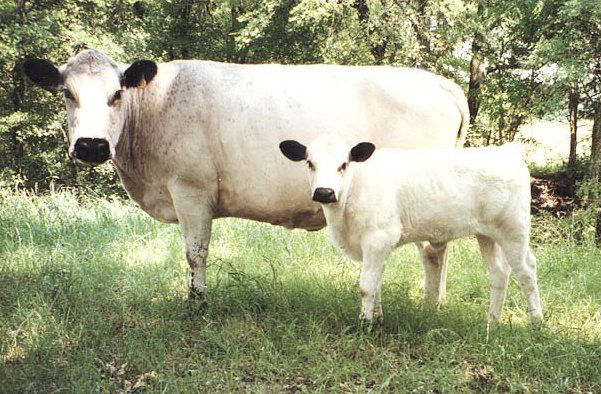Type the name of the breed you're looking for below
[wpdreams_ajaxsearchlite] Don't see the breed your're looking for? Click here and let us know!
British White cattle
| Place of Origin | Great Britain |
| Origin | White cattle (often with black or red ears) are believed to have been highly regarded in Britain and Ireland in very early times, and herds of white cattle were kept as ornamental and sporting animals in enclosed parks for many centuries. They gave rise to the horned White Park cattle, and contributed to the polled British White. However, British Whites are not as genetically distinct from other British breeds as White Parks are, and so there is some doubt about their exact origins; other breeds such as Shorthorn may have contributed to their development. These cattle were kept in the Park of Whalley Abbey, in the Forest of Bowland near Clitheroe. After that time the major portion of the herd was moved to Norfolk, in the early 19th century. This herd was sold off in small lots, largely to nobility in the surrounding countryside, and formed the basis of the British White breed. By the early 20th century these cattle had declined to about 130 registered animals, mainly in the eastern counties of England. By the end of the 20th century numbers had grown to over 1,500 registered animals in the UK and perhaps 2,500 in the US, as well as many in other parts of the world such as Australia, where the breed was first imported by Mrs A Horden in 1958. The UK Rare Breeds Survival Trust lists it as a "minority" breed. |
| Purpose | Like many other traditional breeds, the British White is a dual-purpose animal, producing both beef and milk. Beef animals are normally reared wholly or mainly on grass pasture. The dual-purpose heritage means that many of the cows are good milk producers, allowing their calves to grow very well. British Whites are able to thrive on very poor pasture such as marshland and heathland, making them suitable for conservation grazing – managing natural pasture habitats of high nature conservation value. British White bulls are sometimes used for crossing with dairy cattle, especially for first-calf heifers. The hybrid offspring are normally reared for beef, but due to the British White's dual purpose history some may be suitable for incorporation into the dairy herd. |
| Appearance | The British White has shortish white hair, and has dark points – usually black, but sometimes red. The coloured points include the ears, feet, eyelids, nose and often even teats. It is medium-sized and compactly built. There may be some coloured spots on the body fur, and the skin beneath the fur is usually coloured (grey or reddish), or pink with coloured spots. The colour-pointed pattern is found in many unrelated cattle breeds throughout the world – it is an extreme pale form of the similarly widespread colour-sided or lineback pattern. The red-pointed variant shows in about two per cent of British Whites, but since red colouration is genetically recessive to black in cattle, many of the black-pointed animals also carry the red allele. The colour-pointed pattern shows strongly in crosses with other breeds, often with additional dark spotting if the other parent was solid-coloured. |
| Horns | Naturally polled (hornless) As in other cattle the polled characteristic is dominant over horns, so first crosses are also polled. |
| Cows Average Weight | 454 - 680 kg (1,000 - 1,500 lbs.) |
| Bulls Average Weight | 816 - 1043 kg (1,800 - 2,300 lbs.) |



